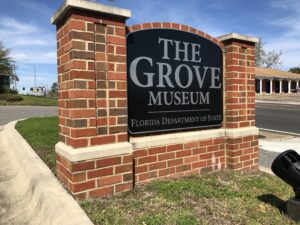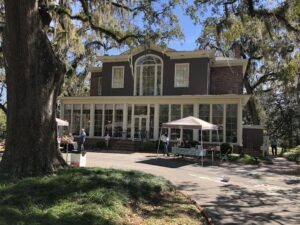
The Grove Museum invited the community out Saturday to help celebrate the third anniversary of the history-filled building’s existence. The Grove Museum had its grand opening on March 11, 2017.
On what has been deemed Grove Day for this historical building, the land on which it sits is filled with fun events for groups of all ages. As you walk along the cemented trail that lies in front of the building, you witness colorful pictures made of chalk illustrated by young children of many ages.
Rachel Solomon, a parent and first-time visitor of The Grove Museum, had nothing but amazing things to say about The Grove Day’s peaceful nature and events. “My kids really enjoyed the event with all of the free information in addition to snacks,” she said.
The Grove Museum has three different levels that focus on slavery and civil rights in American history. According to The Grove Museum’s official website, the mission of the museum is to preserve and interpret the Call-Collins House, its surrounding acreage, and its historical collections in order to engage the public about Tallahassee’s civil rights and American history.
Different activities that took place included a backyard discovery program which taught archeology and the different layers of soil. Very child-friendly, it allowed kids to learn through using fun things such as cookies, pudding and gummy worms to appropriately demonstrate the layers of soil.
The Bureau of Archeological Research (BAR) was also present to teach about artifacts that were found on the property and used activities such as having visitors rebuild broken vases and plates in order to get an idea of what takes place when finding artifacts from historical sites such as The Grove.
From the tours and many informational artifacts and posts, it is learned that there is certainly a layered history. This was a plantation home built by enslaved people from the ground up and still stands more than 200 years later.

Daniel Noel, an employee of The Grove, said, “We know very much that enslaved people built and occupied this space making it what it is today. I think The Grove is important and I think it gives back to the community because I think oftentimes maybe that story or that narrative is kind of overlooked — purposefully forgotten. And I think if you stop speaking about something, then it just ceases to exist in a way,” he said.
Through programming, he said he hopes [The Grove] can speak about the importance of Black people and unrepresented narratives of indigenous people.
The Grove’s executive director, Johnathan Grandage, gave an informational tour from the outside to the inside of the museum. Grandage engaged the crowd with detailed facts about the physique of the of the building.
“Just a few years before this house was built in 1842, we know that there were 2 million bricks sitting at that brick yard near Lake Ella,” he said.
Grandage said that the enslaved people of the land were able to uniquely build the house.
The Grove encompasses large areas of grassy space that welcomes picnics and calming nature walks and free tours for all. It is located at 902 N. Monroe St. and open from 10-4 Wednesday through Saturday.